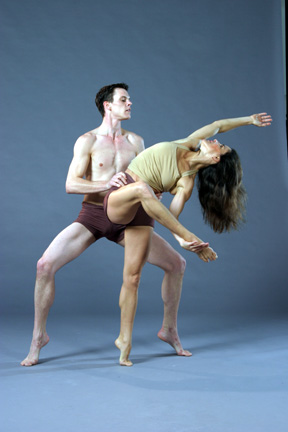Light Summer Fare
Mark
Foehringer Dance Project
Yerba Buena Center for the Arts
San
Francisco, California
J une
18, 2004
By
Rita Felciano
Copyright
© 2004 by Rita Felciano
published June 21, 2004
 The
Mark Foehringer Dance Project’s biggest asset is not the choreography
but its dancers. Foehringer’s ability to find and engage excellent
performers, most of whom are permanent members of other ballet and modern
companies, outstrips his dance making reach. Dancers like Katherine Wells
(Robert Moses’ Kin), Maurya Kerr (LINES Contemporary Ballet), Brian
Fisher and Private Freeman (ODC/SF), Patricia Perez, Ramon Moreno and
Peter Hershey (Ballet San Jose Silicon Valley) get to perform a repertoire
which couldn’t be more different from what they usually are seen
in. It’s a treat for us, and since they so clearly enjoyed themselves
in Foehringer’s sometimes clever, sometimes thin choreography, a
treat for them.
The
Mark Foehringer Dance Project’s biggest asset is not the choreography
but its dancers. Foehringer’s ability to find and engage excellent
performers, most of whom are permanent members of other ballet and modern
companies, outstrips his dance making reach. Dancers like Katherine Wells
(Robert Moses’ Kin), Maurya Kerr (LINES Contemporary Ballet), Brian
Fisher and Private Freeman (ODC/SF), Patricia Perez, Ramon Moreno and
Peter Hershey (Ballet San Jose Silicon Valley) get to perform a repertoire
which couldn’t be more different from what they usually are seen
in. It’s a treat for us, and since they so clearly enjoyed themselves
in Foehringer’s sometimes clever, sometimes thin choreography, a
treat for them.
Foehringer likes his choreography light and light weight. To want to entertain is a fair enough goal. But for choreography to primarily aim to entertain—as Foehringer’s seems to do—it has to stay on the surface of almost anything tackled. In turn that means that pieces outwear their welcome rather quickly. They don’t have staying power. Disappointingly, the evening offered only one new work, a comedic and color-patch costumed (by Susanna Douthit) but rather bland duet Loose Translation, a blow by blow reading of a Donizetti score. Even in today’s financial realities, one got little sense that this is a company on the move, particularly considering that Foehringer has at his disposal this marvelous group of dancers.
The opening, nicely flowing Here to There (1996) featured an all-male octet in a piece whose circular structure suggested a trajectory from community into individuality and back into community again. The work started with the dancers in a circle in which each one acknowledged his presence before spreading out into the wings. They returned one by one with changing running patterns that accumulated gestures of leaning, turns and leaps. Two duets and a solo at the center suggested different kinds of partnerships. Freeman and Fisher’s was lyrical with a lovely arm around the shoulder motive and luscious arabesques that eventually lead to the kind of intimacy where you could rest on your partner’s body or be turned upside down by him. The second duet, for Peter Hershey and Moreno was skippier and faster paced with stiff-legged vertical lifts. After a turbulent lashing out solo for Ventura, the ensemble returned in two opposing quartets that eventually fused together again. Here was very simple but had good bones to its architecture.
From the same first year of the company’s existence, Jammies presented the dancers in pajamas to perform a number of movement skits to a variety of pop tunes. At its best this pretty thin work worked up a touch of whimsy with these restless sleepers fighting pillows, bottoms rising like snores. But some of the slap stick was just too trite, such as a courting duet between Perez, a fire ball of a performer, and a supposedly myopic Moreno. It looked too much like Jerry Lewis. Another one (for Freeman and Angelina Allen) to ‘I am in the mood for love’ might have been title “not tonight, dear, I have a headache.” On the other hand ‘Time after Time’, with Fisher and Wells as two lovers who found each other, had a lovely soft-shoe quality to it.
Even though most of Jammies's humor is rather infantile, Foehringer conveys all of it with movement. That’s an ability which stood him in good stead with the evening’s other major and more intriguing piece Rhapsodia (2000).
Rhapsodia is a three part who-dunnit to Rachmaninov’s “Rhapsody on a Theme of Paganini.” It’s a murder mystery in which the host of a dinner party, upon taking a first sip falls dead into the soup. (Just to avoid unnecessary suspense, it wasn’t the butler but the housekeeper who did it). As costumed (by Kathy Koon), the characters could have come out of an Agatha Christie novel. There is a gigolo (Freeman) who goes after the daughter (Tatiana A’Virmond), a penniless fiancé (Fisher), a boxer (Moreno) who is out of it, and the socialite wife (Wells) who has something to hide. In a series of mad cap sequences, the dining room table splits apart just like the drawing room decorum. Guests accuse each other, get drunk, engage in love trysts, form alliances and grandstand. Fisher and Freeman momentarily hook up with each other, the housekeeper (a stone faced Phaedra Jarrett) knocks the dead man back into the wings, the wife steals a letter and finds out a surprise. One can live with and even like “Rhapsodia’s” concept as a humorous danced murder mystery, but while the individual incidents are smartly timed, the piece drags on for too long.
The program also included a lyrical duet Apres un reve (1997) beautifully danced by Kerr and Artur Sultanov, and Las Vicisitudes (2003) whose central adagio had an attractively languid, almost sleepwalking quality to its partner switching quartet, Kerr, Wells, Sultanov and Jekyns Pelaez.
Photo: Tatiana A’Virmond and Joseph Copely perform in Mark Foehringer’s Las Visicitudes. Photo: Marty Soll.
Originally
published:
www.danceviewtimes.com
Volume 2, Number 23
June 21, 2004
Copyright ©2004 by Rita Felciano
|
|